6×6
6x6
Theater Emory
A compilation of six original new plays
Artistic Director, John Ammerman
Overall Scenic Design by Leslie Taylor
This collection of short one-character plays took place on a stage divided into six distinct areas. Each playing space had a different scenic design and, therefore, a unique lighting design. Each play had a different playwright, director and scenic designer and the stage lighting reflects the strikingly different atmospheres.
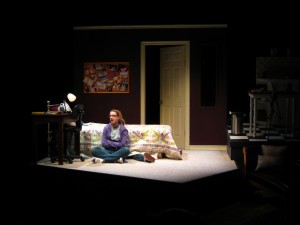 “Is Zoe’s Room Available” is a play that takes place in the main character’s bedroom. She expresses her frustrations to the young man who is passed out beneath her bed. The lighting was realistic and reflected the natural lighting in a teenager’s bedroom.
“Is Zoe’s Room Available” is a play that takes place in the main character’s bedroom. She expresses her frustrations to the young man who is passed out beneath her bed. The lighting was realistic and reflected the natural lighting in a teenager’s bedroom.
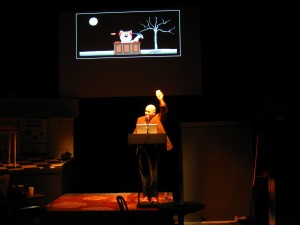 In “Milton’s Revolution,” the main character dramatically ends his career as a comic-strip artist at a convention celebrating his work. The lighting reflected the lighting that would be present in a hotel ballroom presentation.
In “Milton’s Revolution,” the main character dramatically ends his career as a comic-strip artist at a convention celebrating his work. The lighting reflected the lighting that would be present in a hotel ballroom presentation.
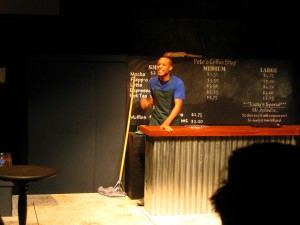 In “Rage,” a coffee shop employee vents his frustrations about the various characters he comes into contact with at his job.
In “Rage,” a coffee shop employee vents his frustrations about the various characters he comes into contact with at his job.
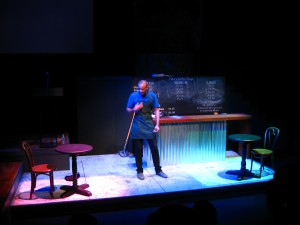 Alfred, the main character in “Rage,” slips into a fantasy world where he expresses his broken heart to imaginary characters. According to the playwright’s wishes, each of these fantastical beings is represented by the pink and green lights focused on the tables.
Alfred, the main character in “Rage,” slips into a fantasy world where he expresses his broken heart to imaginary characters. According to the playwright’s wishes, each of these fantastical beings is represented by the pink and green lights focused on the tables.
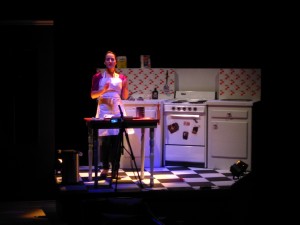 A seemingly normal suburban woman expresses her murderous desires to her video camera in “Incredible.”
A seemingly normal suburban woman expresses her murderous desires to her video camera in “Incredible.”
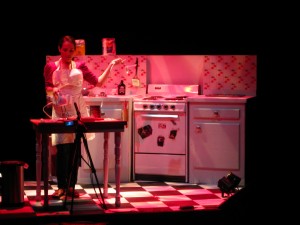 She frames the video as a sort of self-made cooking show. The vibrant colors of lighting reflect the insane surreal quality of play.
She frames the video as a sort of self-made cooking show. The vibrant colors of lighting reflect the insane surreal quality of play.
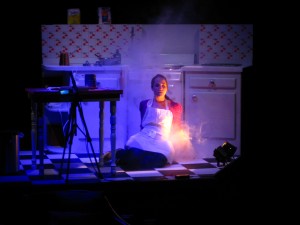 The lighting hits the mad heroine from obscure angles, reflecting the directors desire to bring an expressionist quality to the piece.
The lighting hits the mad heroine from obscure angles, reflecting the directors desire to bring an expressionist quality to the piece.
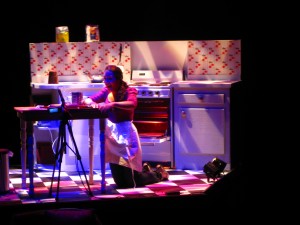 Sharp-angled gobos, strange angles and intense color further promote an expressionist idea in the lighting.
Sharp-angled gobos, strange angles and intense color further promote an expressionist idea in the lighting.
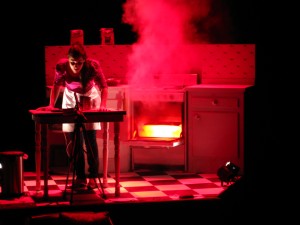 Deep reds and a smoking oven work to create a diabolical effect for the sinister ending of this play.
Deep reds and a smoking oven work to create a diabolical effect for the sinister ending of this play.
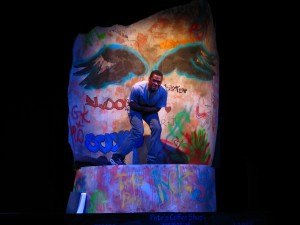 The title character in “The book of Joe” expresses his misunderstood motivations. The lighting highlights the graffiti on the wall behind him.
The title character in “The book of Joe” expresses his misunderstood motivations. The lighting highlights the graffiti on the wall behind him.
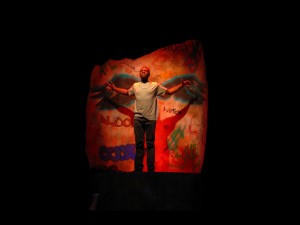 In the final moments of the play, the graffiti becomes Joe’s wings and the lighting turns blood red as he recounts his own death.
In the final moments of the play, the graffiti becomes Joe’s wings and the lighting turns blood red as he recounts his own death.